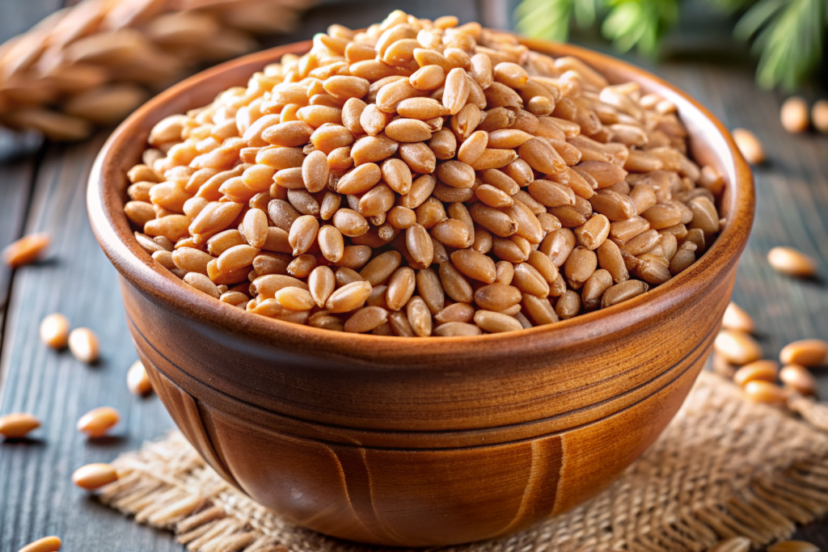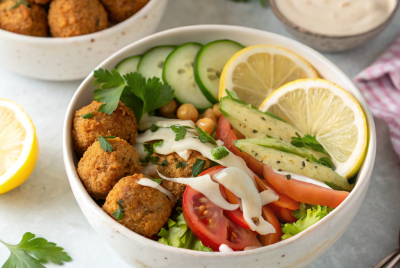Best Gluten Free Substitutes for Farro + 10 Recipes
Farro refers to a trio of ancient grains – emmer, spelt, and einkorn – all belonging to the wheat family. Cultivated for centuries in regions like the Fertile Crescent and Italy, farro has seen a surge in popularity recently, valued for its robust texture, distinctive nutty taste, and numerous nutritional advantages. High in fiber, iron, and protein, it also boasts a low glycemic index. Its versatility shines through in a wide array of culinary creations, from hearty salads and burgers to creamy risottos, making it an excellent choice for culinary experimentation.
However, farro does contain gluten, making it unsuitable for people with celiac disease, gluten intolerance, or non-celiac gluten sensitivity. So, today, I want to talk about gluten free substitutes for farro and share some of my favorite recipes. Make sure you read till the end!
What is Farro?
Farro is one of the oldest cultivated grains that have been sustaining people for thousands of years.
There are three types of farro:
Farro piccolo (einkorn) is the smallest variety. It boasts a slightly nuttier taste and firmer texture, making it particularly well-suited for salads and side dishes.
Farro medio (emmer) is medium-sized and more commonly used. Its chewy texture adds depth to dishes like stews, soups, and risottos, providing a hearty element.
Farro grande (spelt) is the largest variety and requires the longest cooking time. It’s best suited for recipes that benefit from slow cooking, such as hearty casseroles.
These grains have a robust texture and a nutty flavor that makes them a favorite in many kitchens around the world.
Origins of Farro
Farro’s roots trace back to the Fertile Crescent, a historical region in the Middle East known as the cradle of civilization. This nutritious grain was a staple food for ancient civilizations, including the Egyptians and Romans. Over time, farro spread across Europe and eventually found its way to the United States, where it has gained popularity in recent years.
Popularity of Farro
In recent years, farro has made a strong comeback, especially among health-conscious foodies. Its high fiber content, impressive nutritional value, and versatility in various dishes have made it a great addition to many balanced diets. You can find it in grocery stores, local markets, and even as a particular cultivar Anson Mills.
Health Benefits of Farro
Farro is packed with essential nutrients like B vitamins, dietary fiber, and essential minerals. It’s a great source of fiber, which helps maintain a healthy digestive system and can lower the risk of heart disease. Its high protein content makes it an excellent choice for those looking to boost their protein intake. Plus, the grain’s low glycemic index helps manage blood sugar levels, making it suitable for those watching their blood sugar.
Farro and Gluten
While farro offers numerous health benefits, it’s not suitable for everyone. Being a type of wheat, it contains gluten, which can be problematic for people with celiac disease, gluten intolerance, or non-celiac gluten sensitivity. But don’t worry, my gluten-free friends! There are plenty of gluten free substitutes for farro that you can enjoy without compromising on taste or texture.
Gluten Free Substitutes of Farro
Let’s explore some of the best gluten free substitutes for farro that you can easily find at your local grocery store.
1. Quinoa
Quinoa is an ancient pseudograin originating from the Andean region of South America. It’s renowned for its versatile use and mild, nutty flavor.
As a gluten free substitute for farro, quinoa offers a texture that is both tender and slightly chewy, making it suitable for a wide range of dishes including salads, soups, and veggie burgers.
Nutritionally, quinoa stands out as a complete protein, containing all nine essential amino acids, along with a good amount of dietary fiber, vitamins, and minerals.
Unlike farro, quinoa has a shorter cooking time, typically in 15-20 minutes, making it a convenient choice for those seeking gluten-free options without compromising on nutritional value.
2. Brown Rice
Brown rice, a whole grain packed with nutrients, is a fantastic gluten free substitute for farro. Its origins trace back to Asia, where it has been a staple for centuries.
Brown rice has a mild, slightly nutty flavor and a chewy texture that works well in many recipes, from grain bowls to stir-fries. It is high in dietary fiber, essential minerals, and B vitamins, making it a nutritious choice.
Brown rice requires longer cooking times, about 45 minutes, but the health benefits it offers make it worthwhile. It’s a great addition to a gluten-free diet, providing sustained energy and essential nutrients.
3. Buckwheat Groats
Buckwheat groats, despite the name, are gluten-free and not related to wheat. They originate from Central Asia and have a robust, earthy flavor.
Buckwheat groats have a firm yet tender texture, suitable for dishes like pilafs, salads, and porridge. They are rich in essential amino acids, fiber, and antioxidants, making them a nutritious alternative to farro.
Cooking buckwheat groats takes about 20 minutes. Their high nutritional value and unique flavor profile make them an excellent choice for those following a gluten-free diet.
4. Millet
Millet is a small, round grain that has been cultivated in Africa and Asia for thousands of years. It is naturally gluten-free and has a mild, slightly sweet flavor.
Millet’s texture can range from fluffy to creamy, depending on how it is cooked, making it versatile for various recipes like pilafs, casseroles, and porridges. It is a good source of essential minerals, fiber, and B vitamins.
Millet cooks relatively quickly, in about 20 minutes, and is an excellent substitute for farro in many dishes. Its versatility and nutritional benefits make it a valuable addition to any gluten-free diet.
5. Sorghum
Sorghum, an ancient grain from Africa, is gluten-free and known for its slightly sweet, nutty flavor.
Sorghum has a firm, similar chewy texture, suitable for salads, soups, and side dishes. It is high in protein, fiber, and essential nutrients like iron and antioxidants, making it a healthy alternative to farro.
Sorghum requires a longer cooking time, about 50-60 minutes, but its health benefits and unique flavor make it a worthwhile choice for gluten-free diets.
6. Wild Rice
Wild rice, native to North America, is not technically rice but a seed from aquatic grass. It is naturally gluten-free and has a distinctive, earthy flavor.
Wild rice has a firm, chewy texture that works well in salads, soups, and stuffings. It is rich in protein, fiber, and essential minerals like magnesium and phosphorus.
Cooking wild rice takes about 40-45 minutes. Its unique texture and flavor, combined with its nutritional benefits, make it a suitable alternative for farro.
7. Teff
Teff, a tiny grain from Ethiopia, is gluten-free and has a mild, nutty flavor.
Teff has a slightly crunchy texture, making it suitable for porridge, bread, and other baked goods. It is high in protein, has a good source of fiber, and essential minerals like calcium and iron.
Teff cooks relatively quickly, in about 15-20 minutes. Its high nutritional value and versatility make it an excellent gluten free substitute for farro.
8. Fonio
Fonio is an ancient grain from West Africa, known for its light, fluffy texture and mild, nutty flavor. It is naturally gluten-free and highly nutritious.
Fonio’s texture is similar to couscous, making it perfect for salads, side dishes, and porridge. It is rich in essential amino acids, fiber, and iron.
Fonio cooks very quickly, in about 5 minutes, making it one of the fastest-cooking grains. The nutritional benefits of this versatile grain make it a great option for gluten-free diets.
9. Amaranth
Amaranth, a pseudograin from Central and South America, is gluten-free and has a slightly sweet and similar nutty flavor.
Amaranth has a gelatinous texture when cooked, suitable for porridge, soups, and baking. It is a complete protein, providing all nine essential amino acids, and is high in fiber, iron, and magnesium.
Cooking amaranth takes about 20-25 minutes. Its high nutritional content and versatility make it an excellent farro substitute in gluten-free recipes.
10. Chia Seeds
Chia seeds, native to Mexico, are gluten-free and have a mild, neutral flavor.
When soaked, chia seeds form a gel-like texture, making them ideal for puddings, smoothies, and baking. They are rich in omega-3 fatty acids, fiber, and protein.
Chia seeds require no cooking, just soaking for about 10-15 minutes. Their high nutritional value and unique texture make them a versatile addition to a gluten-free diet.
11. Oat Groats
Oat groats, the whole form of oats, are naturally gluten-free if certified as such and have a nutty, slightly sweet flavor.
Oat groats have a chewy texture, making them suitable for porridge, pilafs, and salads. They are high in fiber, protein, and essential vitamins and minerals.
Cooking oat groats takes about 45-50 minutes. Their robust texture and nutritional benefits make them a great alternative to farro.
12. Job’s Tears (Adlay)
Job’s tears, also known as adlay or coix seeds, are gluten-free grains from East Asia with a mild, barley-like flavor.
They have a chewy texture, suitable for soups, porridges, and salads. Job’s tears are rich in protein, fiber, and essential minerals like calcium and magnesium.
Cooking Job’s tears takes about 40-45 minutes. Their unique texture and nutritional profile make them a valuable addition to a gluten-free diet.
13. Corn Kernels
Corn kernels, naturally gluten-free, have a sweet, mildly nutty flavor.
Corn kernels have a crisp, tender texture, suitable for salads, soups, and side dishes. They are rich in fiber, vitamins A and C, and antioxidants.
Corn kernels cook quickly, in about 5-7 minutes, making them a convenient and nutritious substitute for farro.
14. Bamboo Rice
Bamboo rice, infused with bamboo juice, is gluten-free and has a mild, slightly sweet flavor.
It has a chewy texture, suitable for pilafs, risottos, and side dishes. Bamboo rice is rich in B vitamins, essential amino acids, and antioxidants.
Bamboo rice cooks in about 20-25 minutes. Its unique flavor and nutritional benefits make it a great gluten-free alternative to farro.
15. Black Rice
Black rice, also known as forbidden rice, is a gluten-free grain with a rich, nutty flavor.
It has a firm, slightly chewy texture, suitable for salads, side dishes, and desserts. Black rice is high in antioxidants, fiber, and essential minerals.
Cooking black rice takes about 30-35 minutes. Its striking color, unique flavor, and nutritional benefits make it an ideal substitute for farro.
16. Red Rice
Red rice, with its distinctive color and nutty flavor, is naturally gluten-free.
It has a chewy texture, suitable for salads, pilafs, and side dishes. Red rice is rich in fiber, antioxidants, and essential minerals.
Cooking red rice takes about 30-35 minutes. Its nutritional benefits and robust flavor make it a great gluten-free option to farro.
17. Kañiwa
Kañiwa, a lesser-known cousin of quinoa from the Andean region, is gluten-free and has a mild, nutty flavor.
Kañiwa has a crunchy texture, suitable for salads, porridge, and baking. It is rich in protein, fiber, and essential amino acids.
Cooking kañiwa takes about 15-20 minutes. Its nutritional profile and versatility make it a valuable addition to a gluten-free diet.
These gluten free substitutes for farro offer a variety of flavors, textures, and nutritional benefits, making them excellent choices for anyone looking to diversify their diet while maintaining a gluten-free lifestyle.
Comparison of Nutritional Content
The table below provides the main nutritional values per 100g for farro, in comparison to the gluten-free substitutes.
Main Nutritional Contents (per 100g)
| Nutrient | Calories | Protein (g) | Fat (g) | Carbohydrates (g) | Fiber (g) | Calcium (mg) | Iron (mg) |
| Farro | 339 | 12.3 | 2.1 | 68 | 10.3 | 34 | 2.5 |
| Quinoa | 120 | 4.4 | 1.9 | 21.3 | 2.8 | 16 | 2.8 |
| Brown Rice | 111 | 2.6 | 0.9 | 23.5 | 1.6 | 10 | 0.5 |
| Buckwheat Groats | 343 | 13.3 | 3.4 | 71.5 | 10 | 18 | 2.3 |
| Millet | 378 | 11 | 4 | 73 | 8.5 | 8 | 3.9 |
| Sorghum | 339 | 10.6 | 3.3 | 72.1 | 6.7 | 28 | 4.4 |
| Wild Rice | 101 | 4 | 0.3 | 21 | 1.8 | 9 | 1.8 |
| Teff | 367 | 13.3 | 2.4 | 73 | 8 | 180 | 7.6 |
| Fonio | 303 | 11.3 | 1.4 | 69.6 | 3.6 | 43 | 7.7 |
| Amaranth | 371 | 13.6 | 7 | 66 | 6.7 | 159 | 7 |
| Chia Seeds | 486 | 16.5 | 30.7 | 42.1 | 34.4 | 631 | 7.7 |
| Oat Groats | 379 | 13.1 | 6.5 | 67.7 | 10.6 | 54 | 4.9 |
| Job’s Tears (Adlay) | 350 | 12.9 | 2.5 | 78.9 | 2.2 | 4.7 | 2.1 |
| Corn Kernels | 86 | 3.4 | 1.2 | 19.7 | 2 | 2 | 0.5 |
| Bamboo Rice | 360 | 7.6 | 1.3 | 80.1 | 1.2 | – | 1.2 |
| Black Rice | 358 | 6.8 | 2.7 | 76.1 | 4.9 | 28 | 1.8 |
| Red Rice | 360 | 7.5 | 2.7 | 78.9 | 2.8 | 28 | 4 |
| Kañiwa | 364 | 13.3 | 6.4 | 69.3 | 7 | 180 | 7.6 |
Recipes with Gluten Free Substitutes for Farro
Now that you know the best gluten free substitutes for farro, let’s get cooking! Here are some of my favorite gluten-free recipes that you’re going to love. They are also vegan since I am on a plant-based diet. Feel free to be creative and adapt the recipes as per your dietary restrictions or preferences.
1. Brown Rice Salad with Roasted Vegetables
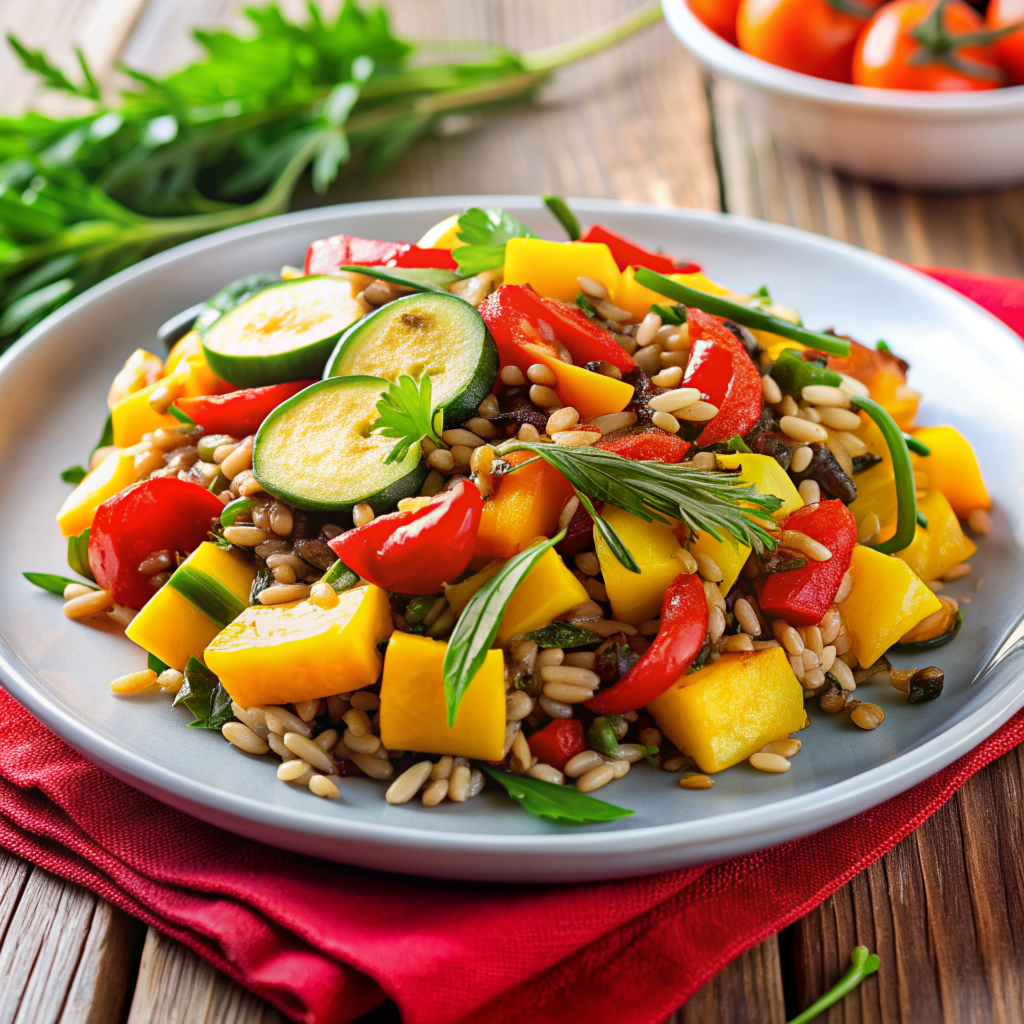
Ingredients:
• 1 cup brown rice
• 2 cups vegetable broth
• 1 zucchini, diced
• 1 red bell pepper, diced
• 1 yellow bell pepper, diced
• 1 red onion, diced
• 2 tbsp olive oil
• 1 tsp dried oregano
• Salt and pepper to taste
• 1/4 cup fresh parsley, chopped
• 2 tbsp balsamic vinegar
Instructions:
1. Preheat the oven to 400°F (200°C).
2. Cook brown rice in vegetable broth according to package instructions.
3. Toss zucchini, bell peppers, and onion with olive oil, oregano, salt, and pepper.
4. Spread vegetables on a baking sheet and roast for 25-30 minutes.
5. Combine cooked brown rice, roasted vegetables, parsley, and balsamic vinegar in a bowl.
6. Serve warm or chilled.
2. Quinoa and Chickpea Stew
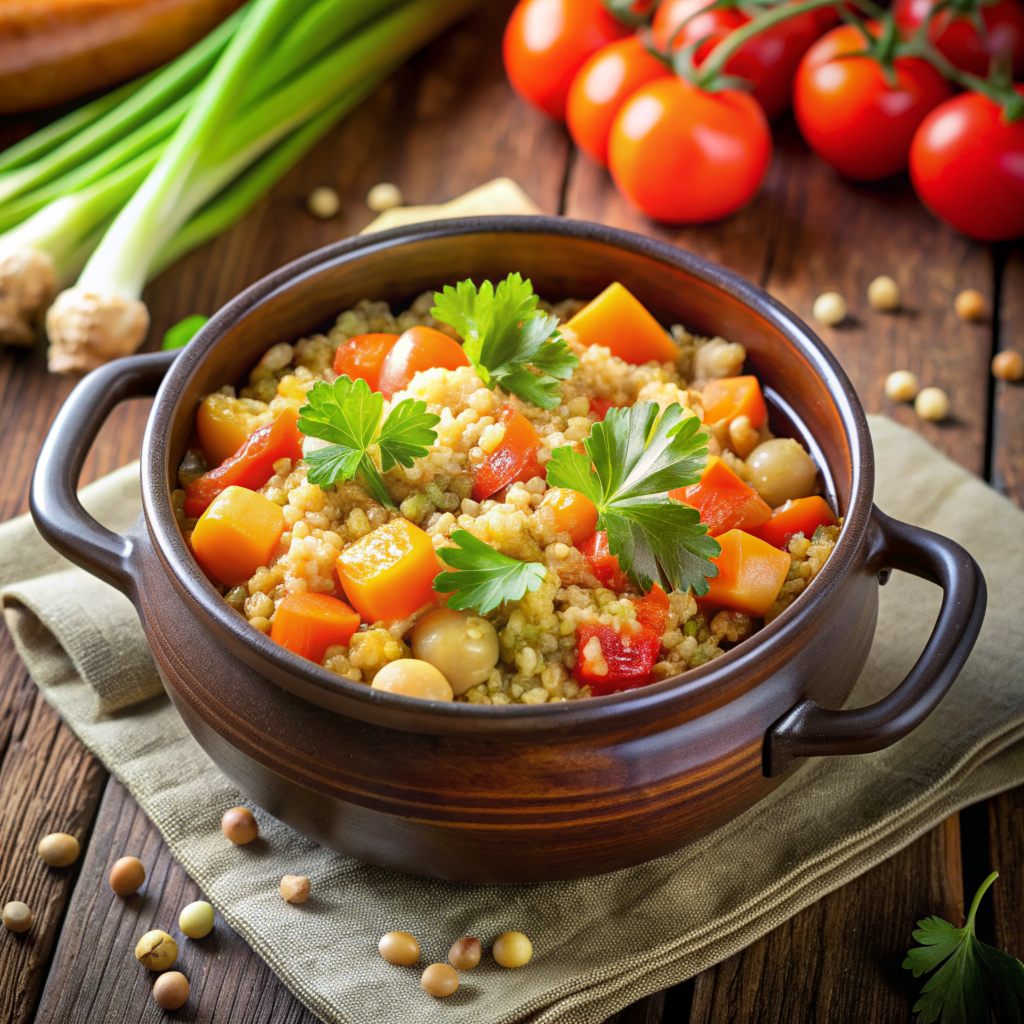
Ingredients:
• 1 cup quinoa
• 2 cups vegetable broth
• 1 can chickpeas, drained and rinsed
• 1 onion, diced
• 2 garlic cloves, minced
• 2 carrots, diced
• 2 celery stalks, diced
• 1 can diced tomatoes
• 1 tsp cumin
• 1 tsp paprika
• Salt and pepper to taste
Instructions:
1. Cook quinoa in vegetable broth according to package instructions.
2. In a large pot, sauté onion and garlic until fragrant.
3. Add carrots and celery, cook until tender.
4. Add chickpeas, tomatoes, cumin, paprika, salt, and pepper.
5. Stir in cooked quinoa, simmer for 10 minutes.
6. Serve hot.
3. Buckwheat Groats and Kale Salad with Lemon-Tahini Dressing
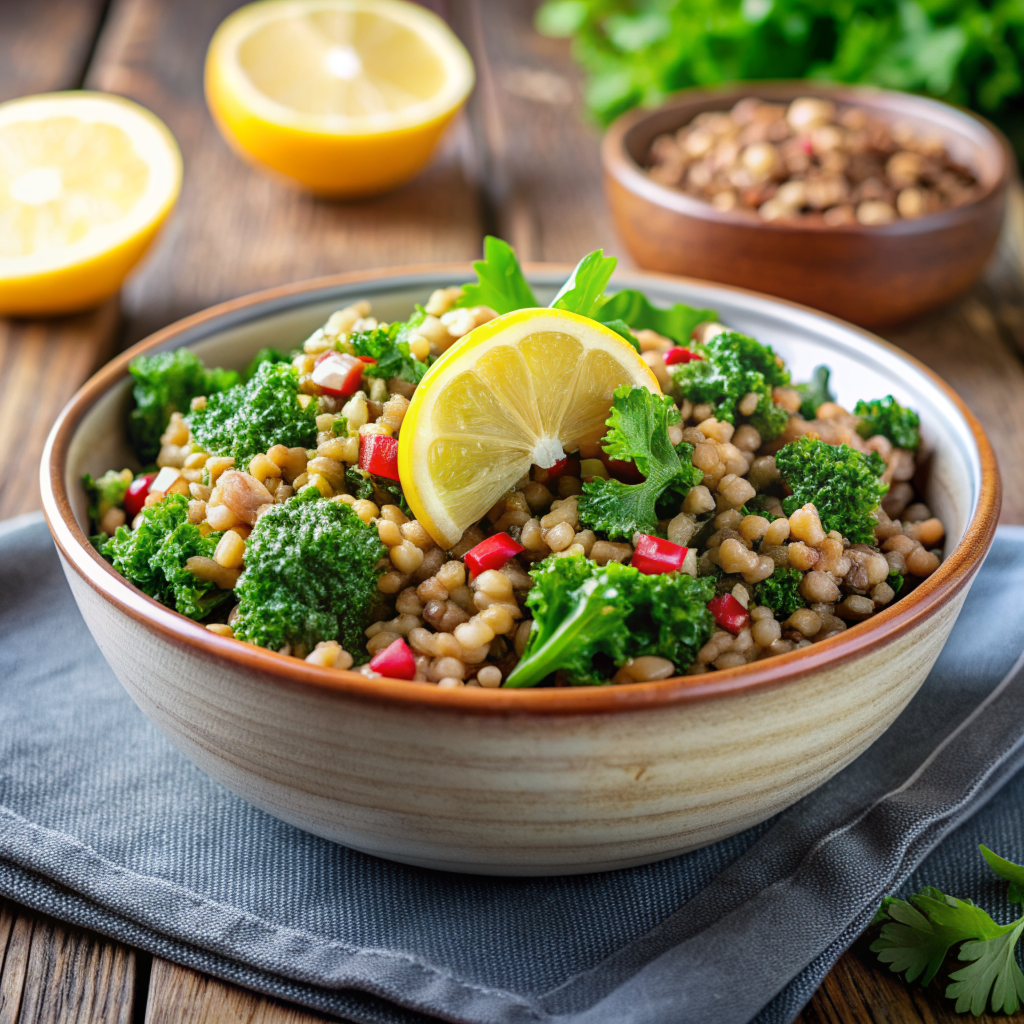
Ingredients:
• 1 cup buckwheat groats
• 2 cups vegetable broth
• 2 cups kale, chopped
• 1/4 cup red onion, thinly sliced
• 1/4 cup dried cranberries
• 1/4 cup sunflower seeds
• 2 tbsp tahini
• 2 tbsp lemon juice
• 1 tbsp olive oil
• Salt and pepper to taste
Instructions:
1. Cook buckwheat groats in vegetable broth according to package instructions.
2. In a large bowl, combine cooked buckwheat groats, kale, red onion, cranberries, and sunflower seeds.
3. In a small bowl, whisk together tahini, lemon juice, olive oil, salt, and pepper.
4. Pour dressing over salad and toss to combine.
5. Serve chilled.
4. Wild Rice Risotto with Mushrooms
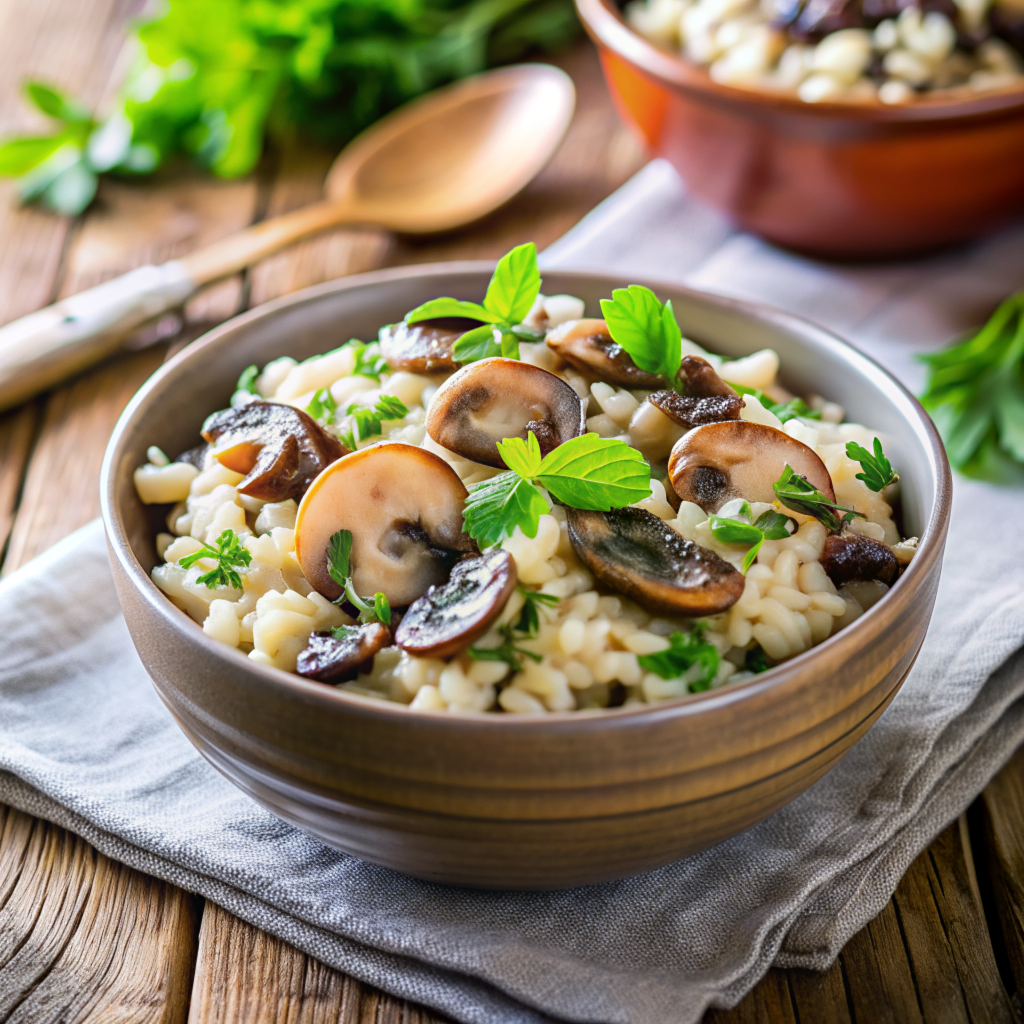
Ingredients:
• 1 cup wild rice
• 4 cups vegetable broth
• 1 onion, diced
• 2 garlic cloves, minced
• 2 cups mushrooms, sliced
• 1/2 cup nutritional yeast
• 2 tbsp olive oil
• Salt and pepper to taste
• 1/4 cup fresh parsley, chopped
Instructions:
1. Cook wild rice in vegetable broth according to package instructions.
2. In a large pot, sauté onion and garlic until fragrant.
3. Add mushrooms, cook until tender.
4. Stir in cooked wild rice and nutritional yeast.
5. Season with salt and pepper, and top with fresh parsley.
6. Serve hot.
5. Millet Stuffed Bell Peppers
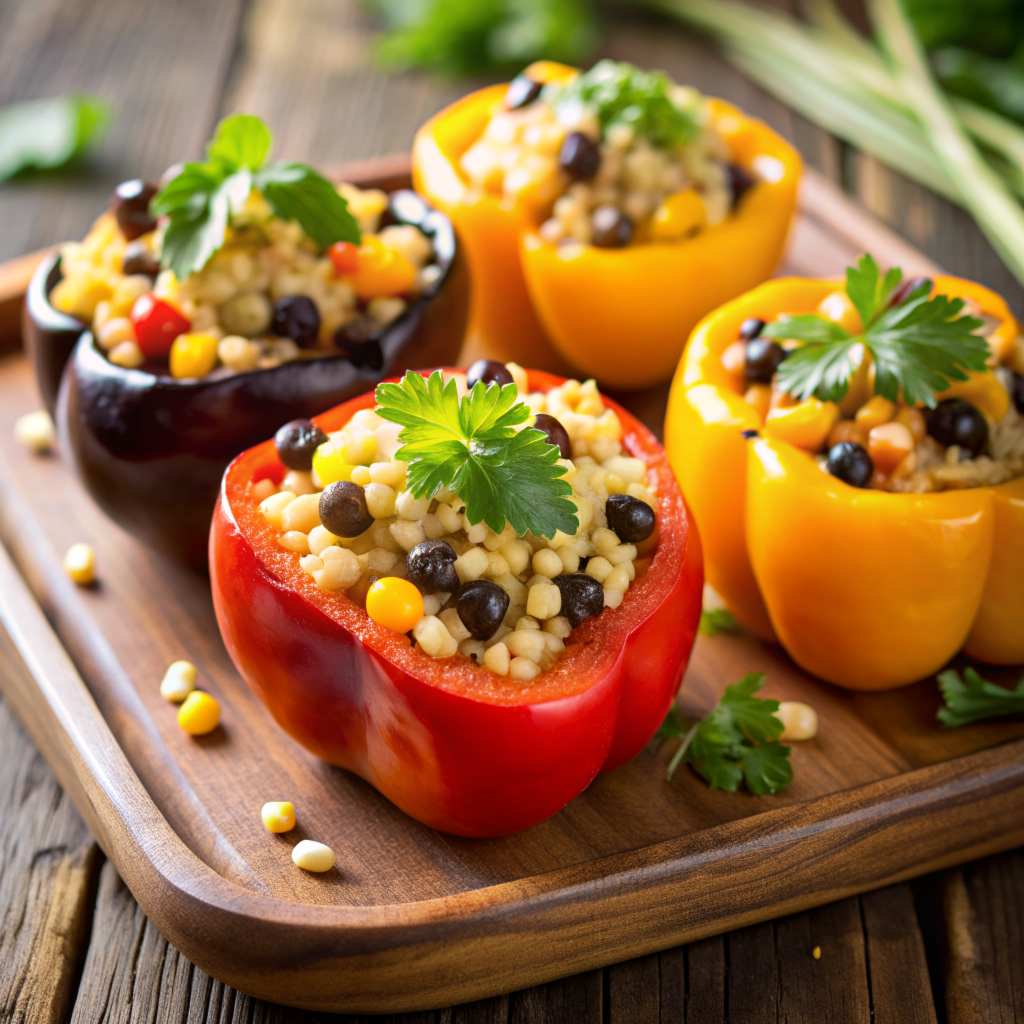
Ingredients:
• 1 cup millet
• 2 cups vegetable broth
• 4 bell peppers, tops cut off and seeds removed
• 1 can black beans, drained and rinsed
• 1 onion, diced
• 2 garlic cloves, minced
• 1 cup corn kernels
• 1 tsp cumin
• 1 tsp chili powder
• Salt and pepper to taste
Instructions:
1. Preheat oven to 375°F (190°C).
2. Cook millet in vegetable broth according to package instructions.
3. In a large pot, sauté onion and garlic until fragrant.
4. Add black beans, corn, cumin, chili powder, salt, and pepper.
5. Stir in cooked millet.
6. Stuff bell peppers with millet mixture and place in a baking dish.
7. Bake for 25-30 minutes, until peppers are tender.
8. Serve hot.
6. Sorghum and Lentil Soup

Ingredients:
• 1 cup sorghum
• 4 cups vegetable broth
• 1 cup lentils, rinsed
• 1 onion, diced
• 2 garlic cloves, minced
• 2 carrots, diced
• 2 celery stalks, diced
• 1 can diced tomatoes
• 1 tsp thyme
• Salt and pepper to taste
Instructions:
1. Cook sorghum in vegetable broth according to package instructions.
2. In a large pot, sauté onion and garlic until fragrant.
3. Add carrots and celery, cook until tender.
4. Add lentils, tomatoes, thyme, salt, and pepper.
5. Stir in cooked sorghum, simmer for 20 minutes.
6. Serve hot.
7. Teff Pilaf with Cranberries and Almonds

Ingredients:
• 1 cup teff
• 2 cups vegetable broth
• 1/2 cup dried cranberries
• 1/4 cup sliced almonds
• 1 onion, diced
• 2 garlic cloves, minced
• 2 tbsp olive oil
• Salt and pepper to taste
Instructions:
1. Cook teff in vegetable broth according to package instructions.
2. In a large pot, sauté onion and garlic until fragrant.
3. Stir in dried cranberries and almonds.
4. Add cooked teff, season with salt and pepper.
5. Serve warm.
8. Fonio Tabbouleh

Ingredients:
• 1 cup fonio
• 2 cups vegetable broth
• 1 cucumber, diced
• 1 tomato, diced
• 1/4 cup red onion, finely chopped
• 1/4 cup fresh parsley, chopped
• 1/4 cup fresh mint, chopped
• 2 tbsp olive oil
• 2 tbsp lemon juice
• Salt and pepper to taste
Instructions:
1. Cook fonio in vegetable broth according to package instructions.
2. In a large bowl, combine cooked fonio, cucumber, tomato, red onion, parsley, and mint.
3. In a small bowl, whisk together olive oil, lemon juice, salt, and pepper.
4. Pour dressing over salad and toss to combine.
5. Serve chilled or at room temperature.
9. Amaranth Breakfast Porridge
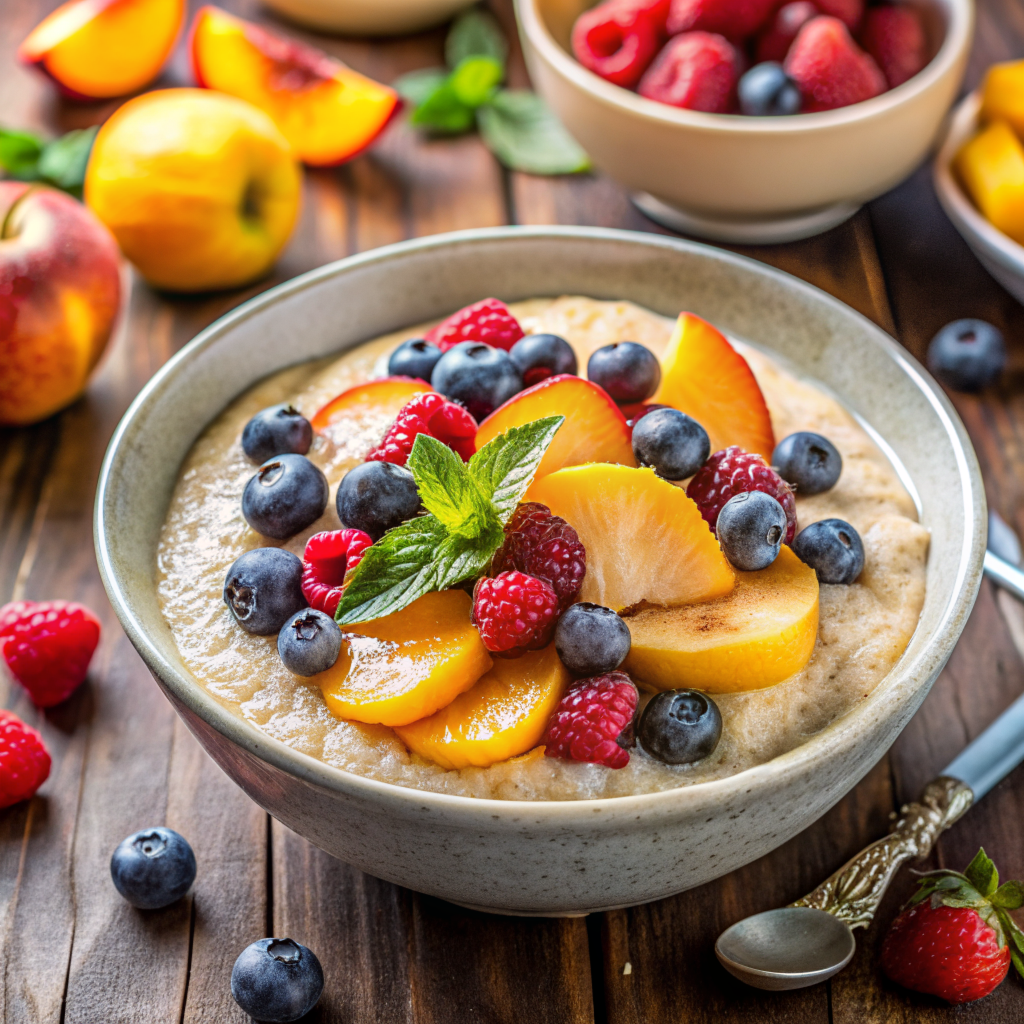
Ingredients:
• 1 cup amaranth
• 2 cups water
• 1 cup almond milk
• 2 tbsp maple syrup
• 1 tsp vanilla extract
• 1/2 tsp cinnamon
• Fresh fruit for topping
Instructions:
1. Combine amaranth and water in a pot, bring to a boil.
2. Reduce heat and simmer for 20 minutes, until water is absorbed.
3. Stir in almond milk, maple syrup, vanilla extract, and cinnamon.
4. Cook for another 10 minutes, until creamy.
5. Serve topped with fresh fruit.
10. Chia Seed Pudding
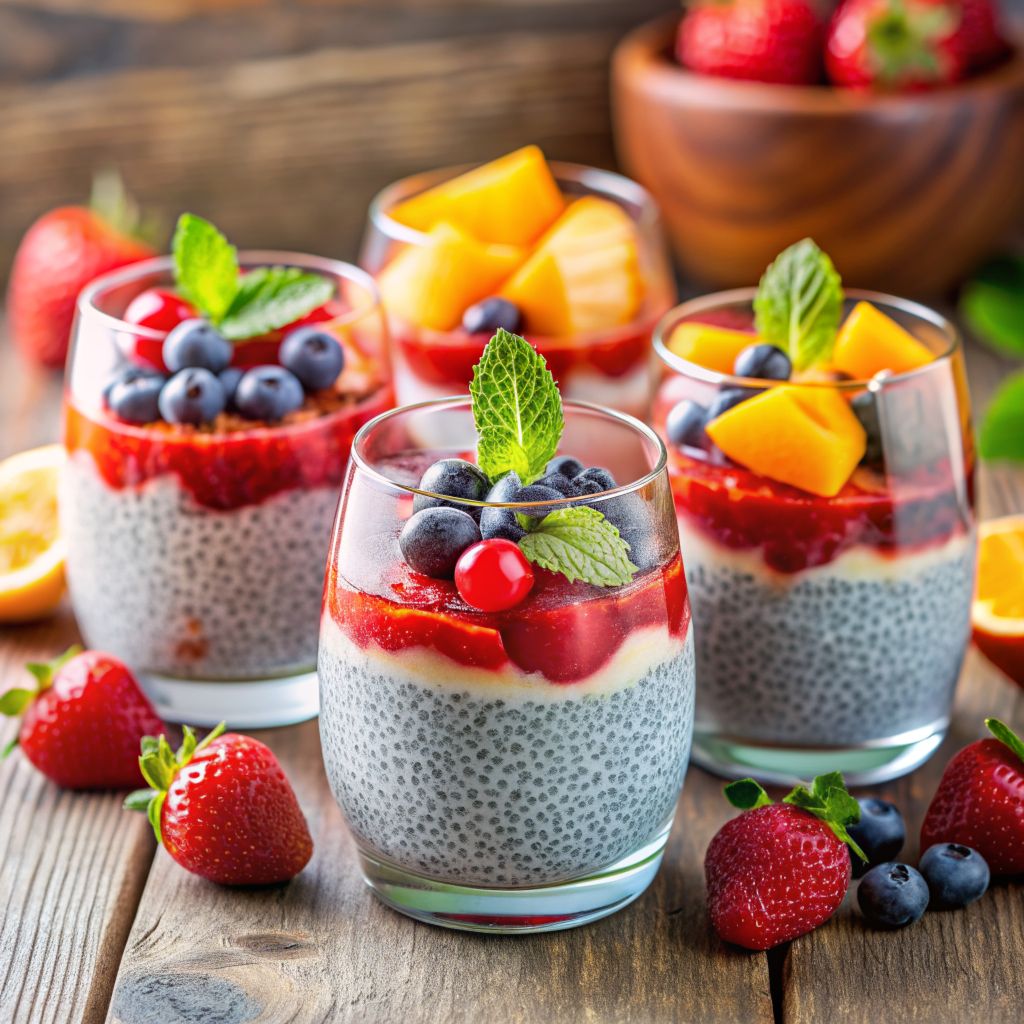
Ingredients:
• 1/2 cup chia seeds
• 2 cups almond milk
• 2 tbsp maple syrup
• 1 tsp vanilla extract
• Fresh fruit for topping
Instructions:
1. In a large bowl, whisk together chia seeds, almond milk, maple syrup, and vanilla extract.
2. Let sit for 10 minutes, then whisk again to prevent clumping.
3. Cover and refrigerate for at least 2 hours, or overnight.
4. Serve topped with fresh fruit.
These gluten-free vegan recipes are delicious and nutritious, providing great alternatives to traditional farro-based dishes. Enjoy exploring these versatile grains and creating new favorites!
Conclusion
I hope you’ve enjoyed this comprehensive guide to the best gluten free substitutes for farro and some delightful recipes to get you started. Whether you’re dealing with gluten sensitivities or simply exploring new grains, these alternatives are sure to bring variety and nutrition to your meals. Remember, eating healthy doesn’t have to be boring. With a little creativity and the right ingredients, you can enjoy delicious, wholesome dishes every day.
For more gluten-free and/or vegan recipes, check out the following links:
Vegan Gluten Free Greek Food: 30 Mediterranean Recipes
Best Dairy-Free Vanilla Cupcakes (Gluten-Free Option)
Best Homemade Gluten Free Ciabatta Bread Recipe
Easy Dairy Free Bread Recipes (Gluten-Free Option)
Keto Vegan Chocolate Chip Cookies | Sugar & Gluten Free
FAQs
1. Can I use gluten free substitutes for farro in any recipe that calls for farro?
Yes, you can use gluten-free substitutes for farro in most recipes that call for farro. While the texture and flavor might vary slightly depending on the substitute you choose, most gluten-free grains like brown rice, quinoa, and buckwheat groats can be used as direct replacements. Just make sure to adjust the cooking times and liquid ratios as needed.
2. Are gluten-free grains as nutritious as farro?
Gluten-free grains can be just as nutritious as farro, though their nutritional profiles may differ. For example, quinoa is a complete protein, while brown rice is high in fiber and essential minerals. Each grain offers unique health benefits, so incorporating a variety of gluten-free grains into your diet can help ensure you get a wide range of nutrients.
3. Where can I find gluten free grains to substitute for farro?
You can find gluten-free grains at most grocery stores, health food stores, and online retailers. Many stores now have dedicated gluten-free sections where you can find a variety of grains like quinoa, brown rice, buckwheat groats, and more. Make sure to check the labels to ensure they are certified gluten-free, especially if you have celiac disease or a severe gluten intolerance.
4. How can I enhance the flavor of gluten free grains in my recipes?
To enhance the flavor of gluten-free grains, consider cooking them in vegetable broth instead of water. You can also add herbs, spices, and aromatics like garlic and onion during the cooking process. Toasting the grains lightly before cooking can also bring out a nuttier flavor. Adding a splash of lemon juice, a drizzle of olive oil, or a sprinkle of nutritional yeast can further elevate the taste.
5. Are there any specific cooking tips for working with gluten free grains?
Yes, here are a few tips for cooking gluten-free grains:
• Rinse grains like quinoa and buckwheat groats thoroughly before cooking to remove any natural bitterness.
• Use the appropriate water-to-grain ratio to ensure the grains cook properly and don’t become too mushy or too dry.
• For a fluffier texture, let the grains sit covered for a few minutes after cooking to allow any remaining moisture to be absorbed.
• If you want a creamier consistency, like in a porridge, add more liquid and stir frequently during cooking.
• Always follow package instructions as cooking times and methods can vary between different grains.

